

Everything To Know About Gold Jewellery
As a precious metal, gold's unique properties - its yellow lustre, malleability, resistance to tarnish and antibacterial properties - have made it a favoured material for jewellery, currency and art. Whether you're an investor seeking to diversify your portfolio, a collector of gold jewellery, or simply curious about this timeless element, our complete gold guide will provide valuable information to enhance your understanding and appreciation of gold.

GOLD JEWELLERY HISTORY
Meaning & Symbolism Of Gold
Gold jewellery has been popular for thousands of years and has become a symbol of wealth, power, and beauty. The history of gold jewellery is rich - from the ancient Egyptians, who covered their pharaohs with elaborate gold artefacts, to the Greek and Roman empires, where gold coins were a standard of currency, this precious metal has played a central role in shaping economies and cultures.
In many beliefs, gold is thought to possess divine qualities, offering protection and attracting good fortune. Gold wedding bands represent an unbreakable bond, reflecting the metal's enduring nature and untarnished beauty and gold cross jewellery is common in Christianity and throughout the Easter celebrations. Gold ornaments are often given as tokens of success and blessings to mark significant milestones, with gifting gold jewellery for special occasions being very popular through-out many cultures.

GOLD SOURCING
How Gold Is Formed
Gold is formed through geological processes deep within the Earth's crust. This process often happens in regions with a history of volcanic activity and tectonic plate movement. Over time, erosion and other natural forces can transport gold into riverbeds and alluvial deposits, where it can be collected through panning and sluicing. Gold deposits are found in various locations worldwide, including South Africa, Australia, Russia, and the United States, particularly in areas like California and Alaska. Significant gold reserves are also found in China and Canada, making these regions key players in the global gold mining industry.
Once gold is extracted, jewellers refine it to remove impurities and achieve the desired purity level. This refining process begins with melting the raw gold and adding materials to help the refinement process as well as other metals such as nickel to adapt the gold content which can make the gold more affordable and change the colour such as for rose gold or white gold. The molten gold is then poured into molds to cool and solidify. Further purification can be achieved through processes such as electrolysis, where the gold is dissolved and then re-deposited onto electrodes, resulting in highly pure gold suitable for crafting fine jewellery.

WHAT IS GOLD PLATED JEWELLERY
Gold vs Gold-filled vs Gold-plated
Gold jewellery comes in various forms, including solid gold, gold-filled, gold-plated, gold vermeil, and hollow gold, each differing in composition, durability, and cost. Choosing between these options depends on your budget, intended use, and preference for durability and longevity. Solid gold is a worthwhile investment for daily wear and heirloom pieces, while gold-filled and gold vermeil offer good durability at a lower cost. So which is the best option for you?
Solid gold is the most expensive but also the most durable and ideal for everyday wear due to its resistance to tarnish and longevity. Gold-plated jewellery has a thin layer of gold electroplated onto a base metal. This is the most affordable option and perfect for fashion jewellery and occasional wear. Similar to hollow gold jewellery, although they are both not solid gold, gold-plated jewellery is still a great option for owning gold jewellery without the high cost. Gold-plated jewellery is ideal for trendy pieces that you might not wear daily but still want to enjoy without a significant investment. Gold-filled jewellery is made by bonding a thick layer of gold to a base metal, making it more durable and resistant to tarnish compared to gold-plated items. Gold vermeil jewellery is made by coating sterling silver with a thick layer of gold, providing a high-quality and long-lasting finish.
Explore Gold-Filled Vs Gold-Plated Vs Gold Vermeil Jewellery
Discover our related blog: White Gold Vs Yellow Gold Vs Rose Gold Jewellery Guide

GOLD PURITY
Gold Hallmarking & Fineness
Gold hallmarking is a critical process in the jewellery industry, ensuring the authenticity and purity of gold jewellery. A hallmark is a mark or series of marks stamped on precious metals, like gold, to certify its content of noble metals and adherence to international standards. At Sonny's Jewellers, all of our jewellery is hallmarked, showing its authenticity and purity.
The fineness of gold, often expressed in parts per thousand, measures the gold purity, with 999 indicating nearly pure gold. 18ct gold (750) is made from 75% gold with the remaining percentage being other metals that add other properties to the gold such as colour variants and extra durability. At Sonny's Jewellers, a lot of our gold jewellery is made from either 9ct or 18ct gold. 9ct gold has 37.5% gold content making it the most affordable for gold jewellery but also the most durable. This makes 9ct gold jewellery perfect for everyday wear. These hallmarks not only guarantee the quality and value of the gold but also provide you with confidence and trust that what you’re buying is authentic.

Types Of Gold Jewellery
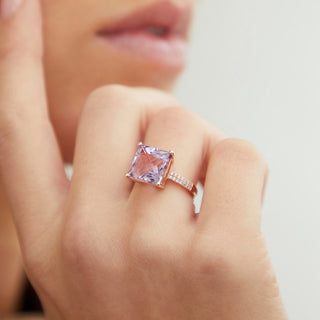
Rose gold’s unique blush-pink colour is achieved by blending gold with copper and brings a romantic and vintage charm to any piece of jewellery.

White gold is often combined with palladium or nickel and plated with rhodium. This offers a modern and sophisticated alternative to platinum.
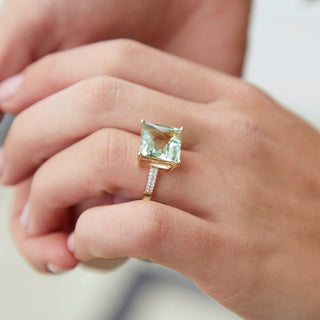
Yellow gold is a very popular and classic choice that is growing in popularity again. It exudes timeless beauty and warmth with its rich and natural hue.
Gold Jewellery
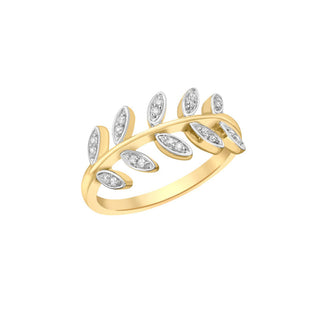



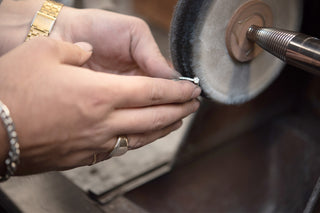
GOLD JEWELLERY CARE TIPS
How To Care For Gold Jewellery
Maintaining gold jewellery involves regular care and cleaning to preserve its shine and prevent damage. To maintain gold jewellery, store it in a soft cloth or padded jewellery box to avoid scratches and keep it away from harsh chemicals, such as chlorine and household cleaners, which can dull its appearance. When cleaning gold jewellery at home, mix a few drops of mild dish soap with warm water and soak the jewellery for about 15-20 minutes. Gently scrub with a soft cloth, paying attention to intricate details, and rinse thoroughly with clean water. Dry with a soft, lint-free cloth to restore its luster. It's advisable to remove gold jewellery before engaging in activities that could damage it, such as swimming in chlorinated pools, showering, exercising, or doing household chores, as these can expose the jewellery to chemicals, sweat, and physical impacts that may tarnish or damage it. Regular professional cleaning and inspections can also help maintain the integrity and brilliance of gold jewellery over time.
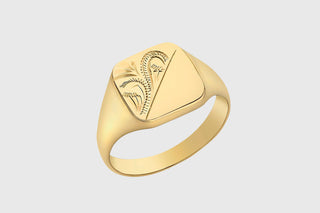
GOLD SIGNET RINGS
Gold Jewellery For Men
Traditionally viewed as a feminine accessory, gold jewellery is now embraced by men and can add a level of sophistication and style. This surge in jewellery for men can be attributed to the breaking of stereotypical gender norms and popular TV shows such as 'One Day' where the male actor is seen wearing a gold signet ring. Men's gold jewellery comes in a variety of forms, from bold gold signet rings that show authority and heritage, to sleek gold chains that add a touch of elegance. Learn more about the history and significance of gold signet rings as jewellery for men.

CUSTOM JEWELLERY
Bespoke Gold Jewellery
With our bespoke jewellery service, we work closely with you to design a piece of jewellery you'll love within your budget. Whether you're looking to create a gold bracelet completely from scratch or if you have an old ring that you want to change the gemstone or metal, our personalised service allows your next piece of jewellery to be exactly what you want with the perfect fit.


























